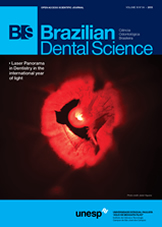Evaluation of implant osseointegration success: Retrospective study at update course
DOI:
https://doi.org/10.14295/bds.2015.v18i4.1157Resumo
Objective: With the scientific and technological advances, the life expectancy of the population has increased over the years. With the advent of dental implants, a new possibility of treatment for oral rehabilitation was created to help or even help overcome the limits of conventional fixed dentures, removable and mainly total. Compared to conventional rehabilitation treatment on natural teeth, rehabilitation on implants has higher rates of success and longevity. Material and Methods: For this research we evaluated the medical records of patients who received surgical treatment for implant placement in the update current school of Implantology ECO (Continuing Studies in Dentistry) in São José dos Campos, in the 2008 'period to 2012, in order to obtain, analyze and relate the following criteria: the patient gender; year and number of installed dental implants; the region of implant installation; the trademark of the installed implant and the successful osseointegration, or process in which there is a rigid fixation between the living bone and the surface of the implant installed. Results: According to the analyzed data, it was observed, along five years, a total of 434 implants placed in patients, mostly women in the mandibular region. However, the total loss was of 5 implants, most in the maxilla and in men, 3 of these, cone-Morse implants, one internal and one external hexagon. Conclusion: Thus, the success rate in the osseointegration implants seems to be more influenced by patient selection and surgical and prosthetic guidelines, compared the experience of the dentist.
Downloads
Downloads
Publicado
Como Citar
Edição
Seção
Licença
TRANSFERÊNCIA DE DIREITOS AUTORAIS E DECLARAÇÃO DE RESPONSABILIDADE
Toda a propriedade de direitos autorais do artigo "____________________________________________________________________" é transferido do autor(es) para a CIÊNCIA ODONTOLÓGICA BRASILEIRA, no caso do trabalho ser publicado. O artigo não foi publicado em outro lugar e não foi submetido simultaneamente para publicação em outra revista.
Vimos por meio deste, atestar que trabalho é original e não apresenta dados manipulados, fraude ou plágio. Fizemos contribuição científica significativa para o estudo e estamos cientes dos dados apresentados e de acordo com a versão final do artigo. Assumimos total responsabilidade pelos aspectos éticos do estudo.
Este texto deve ser impresso e assinado por todos os autores. A versão digitalizada deverá ser apresentada como arquivo suplementar durante o processo de submissão.




























